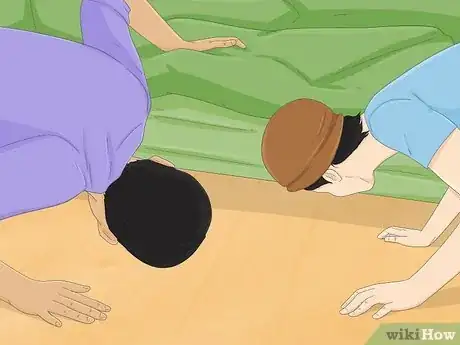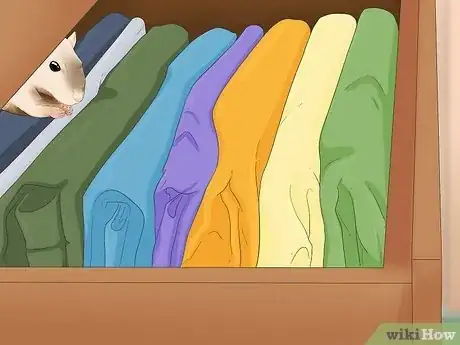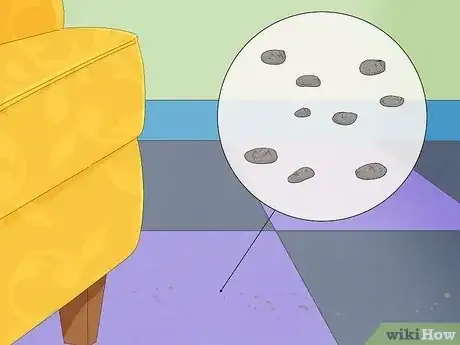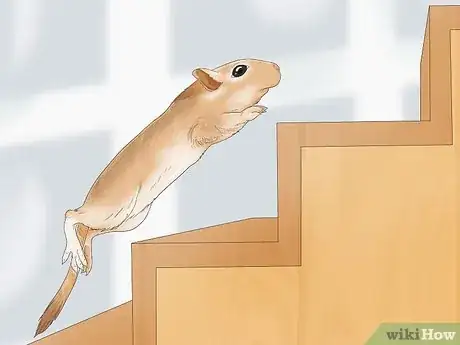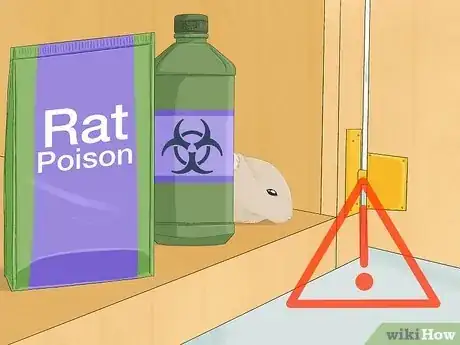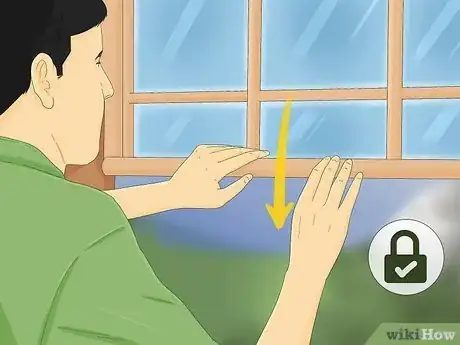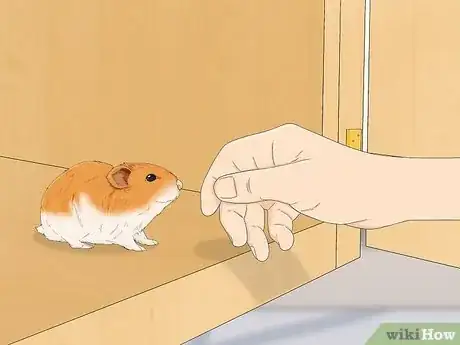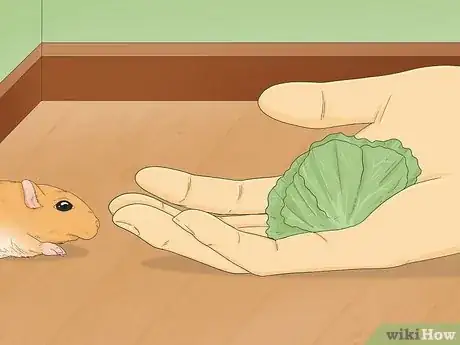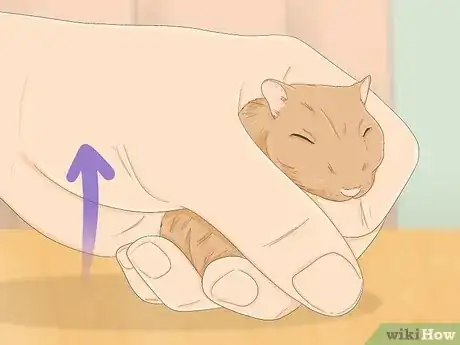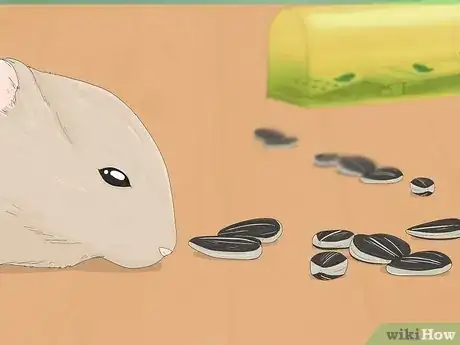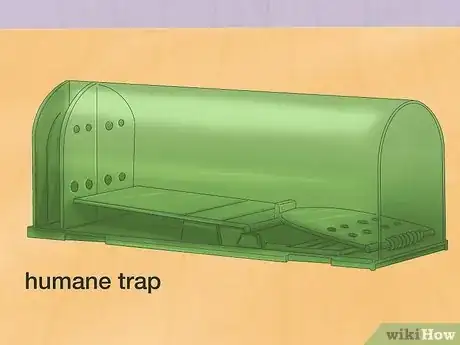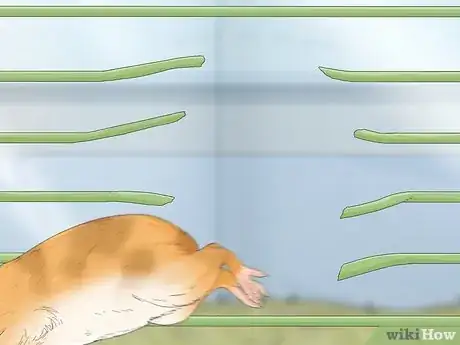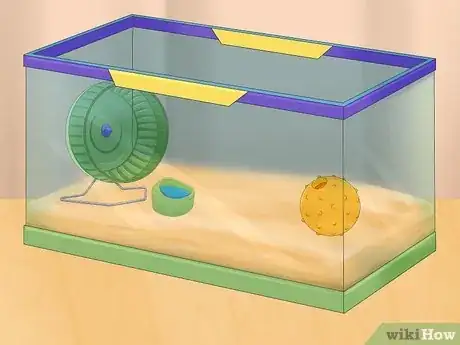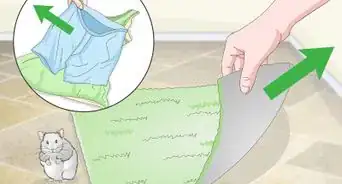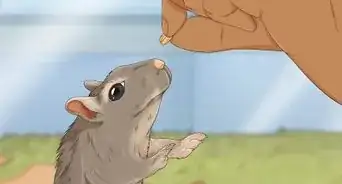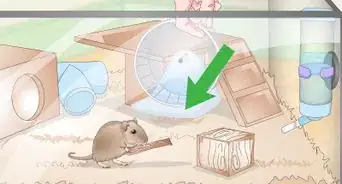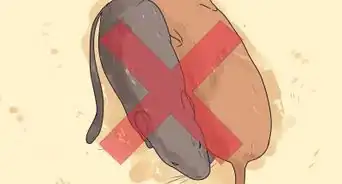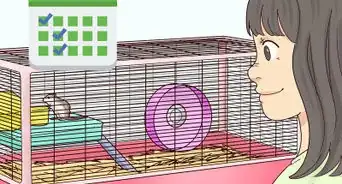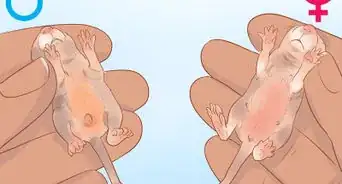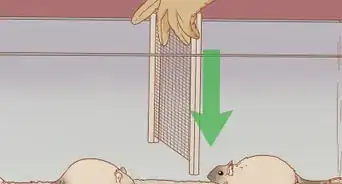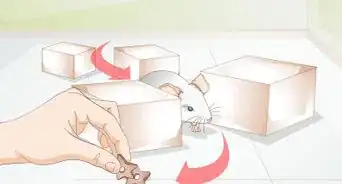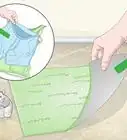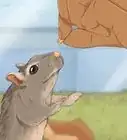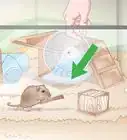This article was co-authored by Pippa Elliott, MRCVS. Dr. Elliott, BVMS, MRCVS is a veterinarian with over 30 years of experience in veterinary surgery and companion animal practice. She graduated from the University of Glasgow in 1987 with a degree in veterinary medicine and surgery. She has worked at the same animal clinic in her hometown for over 20 years.
This article has been viewed 40,565 times.
Gerbils are small and quick creatures that can be really difficult to catch when they escape their cages. If your gerbil ever escapes, there are a variety of methods you can use to get it back. These include luring it with food, cornering it, and trapping it with a humane trap. If you play your cards right, you can quickly and carefully catch your gerbil and return it to its rightful home.
Steps
Locating the Gerbil
-
1Contain the gerbil in 1 room. If your gerbil escapes in front of you, don't let it get out of the room you are in. If you spot the gerbil as you are trying to find it, shut the door of the room that it is in. Cornering the gerbil in a single room will make catching it much easier.[1]
- If you don't see the gerbil escape and you don't know where it is, then you can't assume it is in the same room that you last saw it in.
-
2Ask someone to help you. It can be a lot easier to catch a gerbil on the loose if you have someone to help you do it. Another person can help you search for the animal, corner it, and close off cages or traps before the gerbil escapes again.Advertisement
-
3Check a wide variety of places. Gerbils that escape often look for a nook or cranny to huddle in. This means you often need to search all over the room they escaped into before you can find them.[2]
- If the gerbil escapes in a room that contains accessible food, such as the kitchen, look in food areas that the gerbil could reach first.
- Lay down on the floor and look under all of the furniture in the room.
- Look in piles of clothes and other areas where gerbils might think they can comfortably nest.
-
4Look for signs of the gerbil's movement. To track down a gerbil that is missing and has not been spotted, you should look for signs of where it has traveled. Look for feces, urine, or chewed items, basically anything that shows that the gerbil has traveled through an area. This will narrow down your search area.[3]
-
5Eliminate areas as you search. As you narrow down the search area, block off areas that have no sign that the gerbil has traveled through them. By closing off areas, you will ensure that the gerbil cannot get into those areas as it tries to evade you.
-
6Check the stairs. Gerbils may be found upstairs, as they can jump very high to climb the stairs, but then are often too scared to jump down stairs. This means that they can get caught on individual stairs.
-
7Try to keep the gerbil away from hazards. If you see the gerbil and are trying to corner it, don't move it towards hazards, such as steep drops, toxins, or wires the animal can easily chew through. Cornering it towards these types of areas might create a risk to its health.[4]
- A gerbil cornered towards a steep drop could go off a ledge by accident just because it is scared and confused.
- Also, be sure to keep possible hazards away from the gerbil. For example, keep other pets out of the area.
-
8Keep the gerbil contained, even if you need to take a break. If you need to leave while your gerbil is still on the loose, be sure that you keep it as contained as possible. Close doors and windows and make sure that anyone else that lives in your home knows not to let the gerbil out.[5]
- If you just need to leave the room to get tools for catching the gerbil, try to find someone to watch the animal while you are gone. Having someone stay in the room will allow you to keep track of where the gerbil is.
Luring a Found Gerbil to Your Hand
-
1Corner and approach the gerbil slowly. Once you spot your gerbil, you need to strategically approach it. Make sure that it has nowhere to run past you and nowhere to hide. Then move very slowly towards it, so that it doesn't feel threatened.[6]
- The natural response at this point is often to work quickly, but this often backfires. Gerbils have prey instincts, and a large predator-type creature quickly approaching will cause the natural response of scurrying away.
- If the gerbil is new to you and doesn't really know you, it may run just at the sight of you. If it is acclimated to you, your presence will most likely not scare it off.
-
2Put treats in your hand and offer them to the gerbil. If the gerbil is tamed, it probably knows that you are the person that brings it tasty treats. Put a food that it likes a lot in your hand and slowly move that hand towards the gerbil. It is likely to climb right into your hand.
- You can use the pellets, seed, or vegetables that you usually feed to your gerbil. However, pick what the animal likes to eat best.[7]
- If you have several options, use a food that has a strong smell. This will allow your gerbil to smell it and be lured to it more easily.
-
3Take hold of the gerbil once it is near you or in your hand. As your gerbil approaches the food, pick it up with a swift but gentle movement. Scoot your fingers under its body, as grabbing it from above can scare it away. Then lock your thumb around the top of its body, so that you have a secure grip on it.
- Be sure to be gentle when grabbing it, but also make sure that you don't let it slip out of your hand.
-
4Cover the gerbil to minimize its chance of getting away. If you can't get the gerbil to come all the way into your hand, you may need to grab it when it gets near. Have your helper use a small net or piece of fabric to cover the gerbil so it can be more easily grabbed and can't run away. This is especially important if the gerbil is not acclimated to you.
Trapping a Hiding Gerbil Safely
-
1Lure the gerbil back into its cage. Get some gerbil food and make a trail from the gerbil's general location to their cage. Put extra treats inside the cage. Make sure the cage doors are open and that there is nothing preventing the gerbil from easily entering. Then, when you see the gerbil going into the cage, close the cage doors quickly.[8]
- You may need to move the cage to a place where the gerbil can easily get to it.
-
2Use a bucket trap to catch your gerbil. If you can't get your gerbil to go into its cage or into a box while you are around, you may need to use a trap that will hold the animal until you get it out. To make a simple trap like this you will need a 1 gallon (3.8 l) bucket, a ramp up to the bucket, a towel, and some gerbil food. To set up the trap put the towel and the food at the bottom of the bucket. Then put the ramp up to the side of the bucket.[9]
- The gerbil will be lured towards the smell of the food. It will go up the ramp and then leap into the bucket to get the food. Once in the bucket, it won't be able to get out.
- The towel at the bottom of the bucket will cushion the gerbil's fall.
- You can make the ramp out of stacks of books or a piece of wood.
- Alternatively, use a child's fishing net or butterfly net on a pole. Place a treat on the net and gently scoop up the gerbil when they wander over the net.
-
3Use a commercial humane trap. Instead of using a homemade bucket trap, you can use a commercial version. A humane trap will lure the gerbil into it with the smell of food, and then keep it contained until you can move the animal back into its cage.
- There are a variety of humane traps available at most home improvement and hardware stores.
-
4Hire a professional. If you can't catch your gerbil alone, you may need to call an animal catcher to get it for you. This is an extreme solution that is typically only used if you have tried all other options.
- A pest control professional may be able to place a variety of humane traps around your home that can catch your gerbil safely.
Preventing Future Escapes
-
1Make sure you shut the door securely. Gerbils often escape when their cage doors are accidentally left open. To prevent this, check the door every time you interact with your gerbils, making sure it is closed and latched.
- There are a wide variety of types of cage doors. If you have the type that simply swings closed, make sure that it is latched as well, as gerbils can push against these doors and open them.
-
2Check for possible escape routes. If you have no idea how your gerbil escaped, you should inspect every inch of its cage. Look for bars that have been chewed through and broken pieces that could provide an escape route.
- Gerbils can squeeze through holes as small as 1⁄2 inch (1.3 cm). Make sure all holes this size are filled or blocked off.[10]
- Gerbils can also jump quite high, so if you are using an open top cage, make sure that the gerbil can't jump out of it.
-
3Get a stronger cage. Gerbils are chewers, so they need strong cages. For instance, plastic cages are not good for use with gerbils, as they can easily destroy one. Also, if you use wood or mesh doors, note that gerbils can chew through these rather quickly.[11]
- Glass aquariums work well for gerbils, as the animals are not able to chew through the glass.
-
4Keep your gerbils occupied. If gerbils are bored, then they will try to escape and find some fun things to do outside of their cage. To prevent this, provide them with a variety of toys and foods.
- You should also provide your gerbil with enough bedding so that it can burrow. If it can't create a sheltered place of its own, it may try to get out of the cage to find one.[12]
References
- ↑ https://books.google.com/books?id=R8cPBgAAQBAJ&lpg=PA69&ots=4PaOSyuMUH&dq=hazards%20for%20gerbils&pg=PA69#v=onepage&q=hazards%20for%20gerbils&f=false
- ↑ https://www.omlet.co.uk/guide/gerbils/gerbil_faqs/how_to_find_a_gerbil
- ↑ https://www.omlet.co.uk/guide/gerbils/gerbil_faqs/how_to_find_a_gerbil
- ↑ https://books.google.com/books?id=R8cPBgAAQBAJ&lpg=PA69&ots=4PaOSyuMUH&dq=hazards%20for%20gerbils&pg=PA69#v=onepage&q=hazards%20for%20gerbils&f=false
- ↑ https://books.google.com/books?id=R8cPBgAAQBAJ&lpg=PA69&ots=4PaOSyuMUH&dq=hazards%20for%20gerbils&pg=PA69#v=onepage&q=hazards%20for%20gerbils&f=false
- ↑ https://books.google.com/books?id=R8cPBgAAQBAJ&lpg=PA69&ots=4PaOSyuMUH&dq=hazards%20for%20gerbils&pg=PA69#v=onepage&q=hazards%20for%20gerbils&f=false
- ↑ http://www.humanesociety.org/animals/gerbils/tips/gerbil_food_water_cage_supplies.html?credit=web_id81798438
- ↑ https://www.omlet.co.uk/guide/gerbils/gerbil_faqs/how_to_find_a_gerbil
- ↑ https://www.pets4homes.co.uk/pet-advice/what-to-do-when-a-hamster-escapes.html
About This Article
To catch a gerbil on the loose, start by trying to corner the gerbil in one room. If the gerbil escaped in a room that contains food, look in these areas first. Next, lay down on the floor and look under furniture, in piles of clothes, or in corners. Continue your search by looking for signs of where it’s been, such as urine, feces, or chewed items. Once you spot your gerbil, corner and approach it slowly with treats like seeds or pellets in your hand. After the gerbil approaches the food, pick it up and put it back in its cage. For more tips from our Veterinary reviewer, including how to trap a hiding gerbil safely, keep reading!

